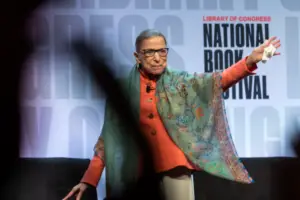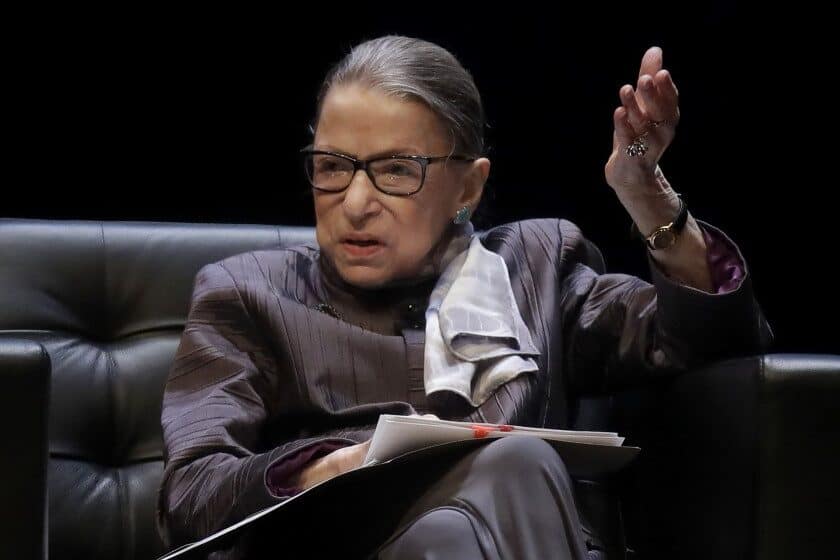The judge of the United States Supreme Court Ruth Bader Ginsburg has died at the age of 87 at her home in Washington, due to complications with pancreatic cancer she suffered, as confirmed in a note by the highest court in the country, in which sat for 27 years. With the popular judge, appointed by Bill Clinton in 1993, leaves a true legend of American justice and an icon of feminism. A representative of the progressive side of the court, your vote has been instrumental in advancing gender equality, and in some of the most divisive social issues in the country, including abortion rights, equal marriage, and the rights of immigrants.
The judge, the second woman appointed to the Supreme Court in history, became a true cult figure among the American left, and her face illustrated T-shirts and badges, which were proudly displayed by young people from all over the country. Many of her fans referred to her as Notorious RBG, in a nod to the famous rapper Notorious BIG Hundreds of people have come tonight to pay tribute to the judge in the Supreme Court, in the capital of the country, where they have lit candles and sung Amazing grace.
“Our nation has lost a jurist of historical stature,” has written the president of the court, John Roberts. “We in the Supreme Court lost a dear colleague. Today we cry, but with the confidence that future generations will remember Ruth Bader Ginsburg as we knew her, a tireless and determined defender of justice.

“Just died? I didn’t know it, ”Trump told reporters shortly before boarding Air Force One, back to Washington, after a rally in Minnesota, 15 minutes after the news of Ginsburg’s death broke. “she lived an incredible life. What else can you say? She was an incredible woman, whether you agreed with her or not, she was an incredible woman who lived an incredible life. “
The death of Ginsburg has important consequences in court: she loses the leader of her progressive wing and, about to start the new course, the vote of the president of the chamber ceases to be decisive in tight cases. But the consequences will be just as profound outside of court.
The vacancy left by Ginsburg in the Supreme Court offers Donald Trump, less than two months before the elections, the opportunity to further consolidate the conservative majority in the court, which has already tilted to the right with two appointments during his term, the by Neil Gorsuch and Brett Kavanaugh, a feat he is used to bragging about.
When a vacancy occurs, the President has the exclusive competence to appoint the Supreme Court justices, who must then be approved by the Senate. The nine magistrates serve for life. The replacement of Ginsburg by a conservative judge would place that sector with a very solid majority, at a time when the Supreme Court is facing important decisions related, among other issues, to abortion, health, or the rights of immigrants. A 6-3 majority would allow the Conservatives to win the cases even if one of their judges decided to vote with the Progressives.
The possibility of appointing more conservative judges was one of the reasons that weighed on many Republicans when it came to voting for Trump, a candidate at least heterodox. In an unusual way, to seduce those conservative voters who did not connect with Trump’s ways, the current president published four years ago a list of potential candidates to fill vacancies in the Supreme Court. A move that was a success and that, just 10 days ago, he has repeated in search of his re-election.

Despite the fact that in 2016 they opposed opening the approval process of a judge appointed by Barack Obama, claiming that holding the hearings in an election year deprived voters of their role in the process, Republican senators have already promised that they will not hesitate. to approve the vacancy, still with a presidential election on November 3. Mitch McConnell, leader of the Republican majority in the Senate, defends in a statement published after Ginsburg’s death, that the change in criteria is due to the fact that now, unlike then, both the Banking House and the Upper House are in the hands of the same match. “The Trump nominee will receive the vote of the United States Senate,” McConnell assured. It opens like this, in the middle of the duel for an iconic figure,
“There is no question that the voters must choose the president and the president must choose the judge for the Senate to consider,” said Democratic presidential candidate Joe Biden, after returning from a campaign trip to Minnesota. . “That is the position that the Republican Senate took in 2016 when there were 10 months left for the elections, and it is the one it must take now.”
Ginsburg had battled cancer since 1999 when she was treated for colon cancer. She has received treatment and has undergone surgery on multiple occasions. Last July, she announced that cancer had returned. And she promised that she would continue in the Supreme as long as her health allowed her. “I have often said that I will remain a member of the tribunal as long as I can do the job at full steam, and I am still fully capable of doing it,” she said.
Born in the New York neighborhood of Brooklyn in 1933, in the years of the Great Depression, the second daughter of a Jewish immigrant from Russia, she went through Cornell, Harvard, and Columbia universities, where she received a law degree. In her early years as a jurist, she combined teaching with fighting as a lawyer for women’s rights. Even before sitting in court, she had successfully defended before her magistrates, in the midst of the civil rights movement of the 1970s, a series of cases that contributed to breaking the wall of gender discrimination.
When Bill Clinton nominated her to the Supreme Court in 1993, however, few imagined that the low-key 60-year-old appeals circuit judge, who even aroused misgivings among some feminist leaders because of her good relations with conservative colleagues, would become a real legend of progressive causes. In the rose garden of the White House, in her speech after being nominated by Clinton for the high court, she had words of memory for her mother. “I pray that she could be all that she would have been, if she had lived in a time when women could aspire and achieve, and daughters would have been as valued as sons,” she said.
Days before her death, according to NPR public radio, Ginsburg issued a statement to her granddaughter Clara Spera, which read: “My most fervent wish is not to be replaced until a new president takes office.

